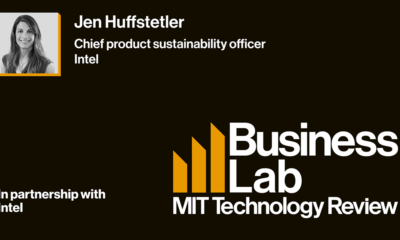Politics
IoT Trends: AI/ML and Edge Computing in IoT
Published
2 years agoon
By
Drew Simpson
There is something magical about the “edge.” For example, in environmental science, one studies “habitat borders” where certain varieties of plants grow heavily at the edge but no further. Similarly, in astronomy, we have seen dramatic phenomena happening at the edge of the universe.
It seems no different with human societies as a new revolution is brewing with high computational powers moving to the edge in what is increasingly called – Edge Computing.
Industry 4.0 and IoT
At its heart, IoT encompasses collecting and analyzing data, insights, and automation of processes involving machines, people, things, and places. IoT is, therefore, a combination of sensors, actuators, connectivity, cloud and edge computing and storage, AI and ML intelligence, and security.
Industry 4.0, also known as the fourth industrial revolution, relies heavily on IoT technology, redefining automotive, transport, healthcare, public mobility, retail, and commerce. Since AI and ML drive all 5G and IoT innovations, their coming together is a natural phenomenon.
5G Supporting Strong IoT
One of the most significant innovations of 5G is providing strong support for IoT, including support for low-cost, long-battery life sensors.
As data storage and computing become a ‘fabric continuum.’ That fabric touches all sectors, and a slew of AI, ML, and Edge Compute solutions will eventually find their optimum zones to reside and roles to play depending on the use case.
Hyperscalers
A new breed of cloud service providers, such as Google, Amazon, and Microsoft, introduced an entirely new scale of IaaS (Infrastructure as a Service), with manageability, transparency, and analytics at competitive prices.
Connectivity
A plethora of options from LoRAWAN, NB-IoT, and rapidly proliferating 5G made offering advanced IoT solutions easier and more feasible.
Edge Computing
Massive advances in computing silicon have made edge devices powerful – allowing localized data assessment and real-time decision making, totally avoiding the round trip to the server.
Some of the other transformations are beginning to be seen, more visibly in terms of engagements of players. For example, telecom operators with Hyperscalers (mentioned above) and transition of Operations Technology (OT such as machine control systems moving into the IT domain).
An increasing number of IoT applications are being conceived and built in the hope they will be consumed and paid for by enterprises and consumers. However, for various reasons, it is clear it will be best delivered from a location closest to the customer, and that zone is a hotbed of activity.
The space closet to the enterprise and consumers is the space that all these players want to dominate.
This space will essentially mean a shift in workloads from central data centers to near-premise or on-premises dedicated edge compute cloud. The central data centers shift could sometimes mean moving the on-premises data center to an on-premises dedicated edge compute cloud.
This suggests a shift from the Capex model to an Opex model, impacting enterprise financial models.
Edge Cloud in an IoT world
In some ways, this increases a new direction in the value chain. The cloud is moving toward the edge, in what is now called the industry as the Edge Cloud.
A Straightforward Explanation of Edge Cloud
The Edge Cloud is simply the combination of smart edge devices (including sensors, nodes, and gateways) with software (algorithms, security stacks, connectivity modules, sensing and actuating components, a processor in a full stack) to handle hundreds of sensors per gateway.
Thousands of such nodes come together automatically with advanced clustering and nodal reconfiguration, re-routing in case of failure in some sort of a super-intelligent IoT network.
Where Does the Tech for Cloud Come From?
The various technologies are already in place, and scalable use cases are becoming common. They even have standardized protocols to offload data to the cloud for non-critical data processing, but retain real-time data processing at the Edge Cloud itself.
Can We Stop AI or ML?
As Silicon volumes build and prices drop, we expect millions of IoT devices to communicate via Edge Clouds and aid human life. The movement of AI/ML toward the edge is an irreversible process and, in fact, a necessity.
The following benefits are clearly visible to the industries that deploy these technologies:
- RT processing ensures low latency responses (improves safety, reduces defect rate)
- Localized security of data
- Data sorting, filtering, and pre-processing before it hits the cloud (eases cloud load)
- The combination of licensed and unlicensed spectrum creates more efficient transport mechanisms.
AI image processing, object detection, and audio/video recognition capabilities have also improved significantly. They are now available as additional capabilities with certain Silicon vendors. We expect these to become even more prevalent and improved pricing as deployments grow.
Is this Edge Cloud for real?
Is there a overhype around Edge Computing? Several assumptions are being made that fuel this extraordinary boom in Edge cloud theory:
- It is still unclear if the Edge Cloud market will be as large as it is made out to be. There is evidence that it can be a high-growth sector. However, the ownership elements of this service are still being defined; telco versus hyperscaler versus a specialist enterprise system integrator versus a Cloud Edge specialist.
- Edge Cloud is a cure-all versus use-case-specific solution. What applications require Edge Cloud capabilities (perhaps those in manufacturing RPA and healthcare versus retail applications) is unclear. Companies are still evaluating the business cases, and the cost of models will play out over time.
- Is Edge Computing a solution looking for an application? Is the round trip delay of a few micro-seconds making the consumer less ready to spend more? Are we mistaking edge storage for edge computing and treating all those applications the same?
4. What about the sunk cost of centralized data centers? Will they now be under-utilized or end up storing only non-critical data? If everything Edge Computing is about Real-Time, then 5G slicing could be a vital element of the solution. If that is the case, will a sustainable business model build-out between telcos and hyperscalers.
Conclusion
These revelations will come to light soon. As the space evolves further, it will become more apparent how AI/ML technologies will realign in the new world order. This will possibly define new positions of the service providers, their alliances with solution providers, and combined business models.
The combination of AI/ML will eventually settle down on a unique landscape that will drive consumers and users in the next decade.
Anjana Sadanandan
Anjana Sadanandan works as Senior Manager – Marketing at Trigent. She has a strong marketing communication background and has worked with several multinational organizations.
You may like
-


The power of green computing
-


China rolls out plan to boost computing power infrastructure
-


Return to the Office: Trends and Tips to Make You a Success
-


10 Business Communication Trends You Need to Adopt in 2024
-


The Intersection of SEO and IoT: The Role of SEO in Promoting IoT Devices
-


IoT Serving is Up Delicious Change: The Food Delivery Landscape
Politics
Fintech Kennek raises $12.5M seed round to digitize lending
Published
6 months agoon
10/11/2023By
Drew Simpson
London-based fintech startup Kennek has raised $12.5 million in seed funding to expand its lending operating system.
According to an Oct. 10 tech.eu report, the round was led by HV Capital and included participation from Dutch Founders Fund, AlbionVC, FFVC, Plug & Play Ventures, and Syndicate One. Kennek offers software-as-a-service tools to help non-bank lenders streamline their operations using open banking, open finance, and payments.
The platform aims to automate time-consuming manual tasks and consolidate fragmented data to simplify lending. Xavier De Pauw, founder of Kennek said:
“Until kennek, lenders had to devote countless hours to menial operational tasks and deal with jumbled and hard-coded data – which makes every other part of lending a headache. As former lenders ourselves, we lived and breathed these frustrations, and built kennek to make them a thing of the past.”
The company said the latest funding round was oversubscribed and closed quickly despite the challenging fundraising environment. The new capital will be used to expand Kennek’s engineering team and strengthen its market position in the UK while exploring expansion into other European markets. Barbod Namini, Partner at lead investor HV Capital, commented on the investment:
“Kennek has developed an ambitious and genuinely unique proposition which we think can be the foundation of the entire alternative lending space. […] It is a complicated market and a solution that brings together all information and stakeholders onto a single platform is highly compelling for both lenders & the ecosystem as a whole.”
The fintech lending space has grown rapidly in recent years, but many lenders still rely on legacy systems and manual processes that limit efficiency and scalability. Kennek aims to leverage open banking and data integration to provide lenders with a more streamlined, automated lending experience.
The seed funding will allow the London-based startup to continue developing its platform and expanding its team to meet demand from non-bank lenders looking to digitize operations. Kennek’s focus on the UK and Europe also comes amid rising adoption of open banking and open finance in the regions.
Featured Image Credit: Photo from Kennek.io; Thank you!
Radek Zielinski
Radek Zielinski is an experienced technology and financial journalist with a passion for cybersecurity and futurology.
Politics
Fortune 500’s race for generative AI breakthroughs
Published
6 months agoon
10/11/2023By
Drew Simpson
As excitement around generative AI grows, Fortune 500 companies, including Goldman Sachs, are carefully examining the possible applications of this technology. A recent survey of U.S. executives indicated that 60% believe generative AI will substantially impact their businesses in the long term. However, they anticipate a one to two-year timeframe before implementing their initial solutions. This optimism stems from the potential of generative AI to revolutionize various aspects of businesses, from enhancing customer experiences to optimizing internal processes. In the short term, companies will likely focus on pilot projects and experimentation, gradually integrating generative AI into their operations as they witness its positive influence on efficiency and profitability.
Goldman Sachs’ Cautious Approach to Implementing Generative AI
In a recent interview, Goldman Sachs CIO Marco Argenti revealed that the firm has not yet implemented any generative AI use cases. Instead, the company focuses on experimentation and setting high standards before adopting the technology. Argenti recognized the desire for outcomes in areas like developer and operational efficiency but emphasized ensuring precision before putting experimental AI use cases into production.
According to Argenti, striking the right balance between driving innovation and maintaining accuracy is crucial for successfully integrating generative AI within the firm. Goldman Sachs intends to continue exploring this emerging technology’s potential benefits and applications while diligently assessing risks to ensure it meets the company’s stringent quality standards.
One possible application for Goldman Sachs is in software development, where the company has observed a 20-40% productivity increase during its trials. The goal is for 1,000 developers to utilize generative AI tools by year’s end. However, Argenti emphasized that a well-defined expectation of return on investment is necessary before fully integrating generative AI into production.
To achieve this, the company plans to implement a systematic and strategic approach to adopting generative AI, ensuring that it complements and enhances the skills of its developers. Additionally, Goldman Sachs intends to evaluate the long-term impact of generative AI on their software development processes and the overall quality of the applications being developed.
Goldman Sachs’ approach to AI implementation goes beyond merely executing models. The firm has created a platform encompassing technical, legal, and compliance assessments to filter out improper content and keep track of all interactions. This comprehensive system ensures seamless integration of artificial intelligence in operations while adhering to regulatory standards and maintaining client confidentiality. Moreover, the platform continuously improves and adapts its algorithms, allowing Goldman Sachs to stay at the forefront of technology and offer its clients the most efficient and secure services.
Featured Image Credit: Photo by Google DeepMind; Pexels; Thank you!
Deanna Ritchie
Managing Editor at ReadWrite
Deanna is the Managing Editor at ReadWrite. Previously she worked as the Editor in Chief for Startup Grind and has over 20+ years of experience in content management and content development.
Politics
UK seizes web3 opportunity simplifying crypto regulations
Published
6 months agoon
10/10/2023By
Drew Simpson
As Web3 companies increasingly consider leaving the United States due to regulatory ambiguity, the United Kingdom must simplify its cryptocurrency regulations to attract these businesses. The conservative think tank Policy Exchange recently released a report detailing ten suggestions for improving Web3 regulation in the country. Among the recommendations are reducing liability for token holders in decentralized autonomous organizations (DAOs) and encouraging the Financial Conduct Authority (FCA) to adopt alternative Know Your Customer (KYC) methodologies, such as digital identities and blockchain analytics tools. These suggestions aim to position the UK as a hub for Web3 innovation and attract blockchain-based businesses looking for a more conducive regulatory environment.
Streamlining Cryptocurrency Regulations for Innovation
To make it easier for emerging Web3 companies to navigate existing legal frameworks and contribute to the UK’s digital economy growth, the government must streamline cryptocurrency regulations and adopt forward-looking approaches. By making the regulatory landscape clear and straightforward, the UK can create an environment that fosters innovation, growth, and competitiveness in the global fintech industry.
The Policy Exchange report also recommends not weakening self-hosted wallets or treating proof-of-stake (PoS) services as financial services. This approach aims to protect the fundamental principles of decentralization and user autonomy while strongly emphasizing security and regulatory compliance. By doing so, the UK can nurture an environment that encourages innovation and the continued growth of blockchain technology.
Despite recent strict measures by UK authorities, such as His Majesty’s Treasury and the FCA, toward the digital assets sector, the proposed changes in the Policy Exchange report strive to make the UK a more attractive location for Web3 enterprises. By adopting these suggestions, the UK can demonstrate its commitment to fostering innovation in the rapidly evolving blockchain and cryptocurrency industries while ensuring a robust and transparent regulatory environment.
The ongoing uncertainty surrounding cryptocurrency regulations in various countries has prompted Web3 companies to explore alternative jurisdictions with more precise legal frameworks. As the United States grapples with regulatory ambiguity, the United Kingdom can position itself as a hub for Web3 innovation by simplifying and streamlining its cryptocurrency regulations.
Featured Image Credit: Photo by Jonathan Borba; Pexels; Thank you!
Deanna Ritchie
Managing Editor at ReadWrite
Deanna is the Managing Editor at ReadWrite. Previously she worked as the Editor in Chief for Startup Grind and has over 20+ years of experience in content management and content development.
